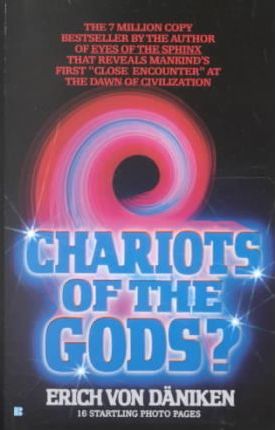When I was in about 5th grade I got really into Greek Mythology…so much so that I began to tell people it was my religion, and it became sort of a “problem.” This intense phase was brought on by 3 distinct things: the cool looking artwork in D’aulaire’s Book of Greek Myths, fond memories of the original “Clash of the Titans” and a fascination with the Nintendo game “Kid Icarus.” But let all this talk of bizarre childhood obsessions stop there (for this entry anyway!) While I was going through my Greek myths era, my mother informed me of a book called “Chariots of the Gods” by Erich Von Daniken which claimed that ancient gods and goddesses were actually space aliens whose advanced technology was interpreted as supernatural power by primitive peoples. “This is heresy!” I thought to myself, and I remember actually not liking the idea of my gods not really being true gods, but merely creepy aliens.
Fast forward to a couple years ago, and as a dude who has seen a lot of Twilight Zone episodes, I began to get interested in the Ancient Astronaut Theory for all its imagination.So I finally picked up a copy of “Chariots of the Gods” to examine the “evidence” for myself.The crux of Von Daniken’s argument seems to be that many ancient civilizations had produced artifacts and monuments which were uniquely more advanced than the era from which they were were constructed, and therefore may have originated with the assistance of visitors from outer space. The obvious problem with this theory, is that in order for long-distance interplanetary space travel to occur, the aliens would have to be thousands if not millions of years more advanced than we are today. Thus, finding an artifact that appears a few hundred or thousand years ahead of it’s time in say 5000 BC, would not be sufficient. We would have to find artifacts that are well in advance of anything even in today’s current technology. Perhaps such objects do exist, and we are as yet still too dumb to recognize them (think of the monolith in 2001 A Space Odyssey.) But I doubt it. All of this would of course be highly insulting to the wisemen of the primitive civilizations who busted their (and their slaves’) asses to build and figure out these early breakthroughs in scientific achievement.
The book offers all sorts of other superficial and subjective “proof” such as ancient drawings which may or may not depict astronauts and vague biblical and mythological references to spacecrafts…all of which are obscure and open to interpretation. It’s somewhat telling when the most “compelling” evidence is all the least tangible stuff. To me, the only eerily curious thing in the book is how some ancient peoples seemed to have knowledge of how the Earth looked from an aerial view when no form of flight existed.
And here is where “Chariots of The Gods” finally shines. Whereas it flunks the evidence test badly, it does not fail to set the wheels of curiosity and imagination in motion. When Lowell claimed to have observed canals on Mars through his telescope (I have been to the Lowell Observatory in Flagstaff a few times now) he turned out to be completely wrong. But such claims sparked wild interest in Mars, and among those who became interested spawned many other theories about Mars, which led to their scientific investigation and subsequently a deeper understanding of the red planet.
Such is exactly what Von Daniken achieves with his imaginative pseudoscientific ramblings. Based on the scant evidence he provides, it’s highly unlikely that we’ve ever been visited by beings from other planets. But it begs a deeper question, which is this: If small insects and micro organisms have little or no capacity to comprehend the world of higher intelligence lifeforms like humans, then what advanced lifeforms and fantastic realities out there do we as humans lack the capacity to understand, with our relatively primitive minds?
In other words, ants are to humans as humans are to ?
One of my favorite Twilight Zone episodes is called “5 Characters in Search of an Exit,” which tells the story of a group of people trapped in a giant room. They don’t know how they got there, who they are, or even what they are. And they spend their time trying trying to find a way out, in order to understand what they are. I won’t give away the ending, but one of them manages to climb out at the end, and it’s revealed who and what they are. They are a microcosm for us though. Perhaps if someday we travel far enough into space, and climb high enough into scientific understanding we may find ourselves on the tip of the tiny spoon of some gargantuan creature the size of which is larger than anything we can fathom at the present time, with our universe being but a mere morsel. Until then, I shall remain skeptically curious.

